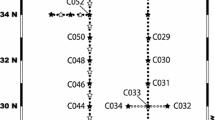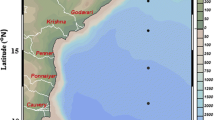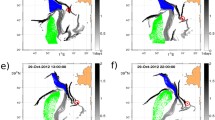Abstract
AROUND the British Isles thermal fronts1 develop during the summer months between cold, well mixed waters that are relatively rich in inorganic nutrients and warm, well stratified waters that are nutrient depleted2. The surface standing crop of phytoplankton is generally high in the marginally stratified frontal zone, particularly where the water is deep (for example, off Ushant and around Orkney and Shetland)2, although these surface waters are generally low in inorganic nutrients. To understand the growth of these frontal blooms, therefore, the scales3 of non-tidal motion that determine the exchange of chemical and biological properties in frontal regions need to be identified. Although the frontal boundaries are almost in geostrophic balance, they are unstable and are characterised by cyclonic eddies with a spatial extent of 20–40 km which can persist for a few days4. These eddies probably have an important influence on phytoplankton growth through the transfer of nutrients as well as phytoplankton across the frontal zone. Furthermore, as the division time of the plant cells is relatively short (∼1 d), growth of the population may actually occur in the eddy transfer process. In this letter a series of observations on the Ushant frontal system, planned to investigate this problem, are described.
Similar content being viewed by others
References
Simpson, J. H. & Hunter, J. R. Nature 250, 404–406 (1974).
Pingree, R. D., Holligan, P. M. & Mardell, G. T. Deep Sea Res. 25, 1011–1028 (1978).
Denman, K. L. & Platt, T. J. Mar. Res. 34, 593–601 (1976).
Pingree, R. D. J. mar. Biol. Ass. U.K. 58, 955–963 (1978).
Holligan, P. M. in Spatial Patterns in Plankton Communities (ed. Steele, J. H) 221–238 (1979).
Pingree, R. D., Pugh, P. R., Holligan, P. M. & Forster, G. R. Nature 258, 672–677 (1975).
Pingree, R. D. & Mardell, G. T. Deep Sea Res. 23, 551–555 (1976).
Author information
Authors and Affiliations
Rights and permissions
About this article
Cite this article
PINGREE, R., HOLLIGAN, P. & MARDELL, G. Phytoplankton growth and cyclonic eddies. Nature 278, 245–247 (1979). https://doi.org/10.1038/278245a0
Received:
Accepted:
Issue Date:
DOI: https://doi.org/10.1038/278245a0
- Springer Nature Limited
This article is cited by
-
Tidal front and its relation to the biological process in coastal water
Ocean Science Journal (2010)
-
Numerical study of tidal front with varying sharpness in spring and neap tidal cycle
Journal of Oceanography (2006)
-
Modern bryomol-sediments in a cool-water, high-energy setting: the inner shelf off Northern Brittany
Facies (2001)
-
Characteristics of the eddy caused by Izu-Oshima Island and the Kuroshio branch current in Sagami Bay, Japan
Journal of Oceanography (1994)
-
Optical characterization of primary productivity across a coastal front
Marine Biology (1987)





